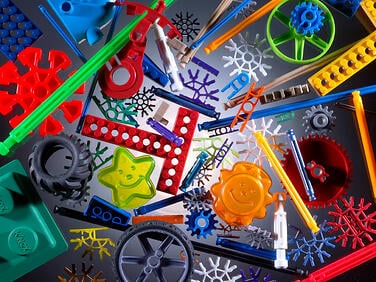The ubiquity of plastic injection molding has produced a plethora of resins to choose from. That said, there are five which are consistently at the top of any molder’s list when it comes to utility. Forthwith, a handy comparison chart:
| Materials | Tensile Strength (73° F) (Units: psi) |
Flexural Modulus of Elasticity (73° F) (Units: psi) |
Izod Impact (Notched) (73° F) (Units: ft-lbs/in) |
Heat Deflection Temperature (66 psi / 264 psi) (Units: °F) |
Water Absorption (24 hr Immersion) (Units: %) |
| ABS | 4,100 | 304,000 | 7.7 | 200° / 177° | 0.3 |
| Acetal | 10,000 | 420,000 | 1.5 | 336° / 257° | 0.25 |
| High Impact Polystyrene | 3,500 | 310,000 | 2.8 | – / 196° | – |
| LDPE | 1,400 | 30,000 | no break | 122° / – | 0.1 |
| Polypropylene | 5,400 | 225,000 | 1.2 | 210° / – | slight |
ABS (acrylonitrile butadiene styrene)
Possessing remarkable toughness, impact and temperature resistance, and just plain, good old-fashioned strength, acrylonitrile butadiene styrene (ABS) is a perennial favorite in a wide range of industries and applications, from car manufacturing to home-building. ABS combines the stamina and rigidity of acrylonitrile/ styrene polymers with the toughness of polybutadiene rubber. With its ease of mold-ability and colorfast, high quality surface finish, ABS is the “go-to” resin for many folks, even though it has no precise melting point.
ABS materials can be molded using any of the conventional thermoplastic production methods. It easily adheres to itself, as well as similar plastics and most metal coatings. This compatibility makes it ideal for thousands of uses.
For instance, it’s frequently found in kitchen appliances, cell phones, computer and other office equipment. ABS can also be used in musical instruments, golf clubs, medical devices, lawn mower engine covers, and interior/exterior automobile trim and shower heads. When extruded into a filament, ABS is optimal for use in 3D printers.
Celcon® (Acetal)
Celcon® is the brand name for polyoxymethylene (POM), polyacetal, or polyformaldehyde. This thermoplastic offers superior toughness, excellent durability, ideal creep resistance, notable chemical solvent resistance, no-fuss colorization, heat distortion and low-moisture permeability.
Renowned as a food and beverage resin, Celcon is also used for mechanical, automotive, and household applications. And it is the perfect choice for molding toy parts.
Celcon® is frequently used in parts that physically touch another surface. Common point-of-contact pieces include plastic gears, because it dramatically reduces the friction that comes from contact.
It should not be utilized in high-heat environments, however, and is subject to UV degradation if exposed to sunlight.
Polypropylene
And now we come to polypropylene (PP), known as plastic “steel,” because of its almost one of the most widely manufactured plastics in the world. It’s famous for its chemical resistance, elasticity, toughness, fatigue resistance, insulation properties, and transmission properties. Although flammable and vulnerable to UV radiation, polypropylene still boasts resistance to electricity and chemical solvents.
A host of applications can used polypropylene, including plastic packaging, electrical equipment, household appliance, automotive, and construction industries. It can be easily customized by including special additives or changing the manufacturing process.
HIPS

High-impact polystyrene (HIPS) provides good impact resistance, excellent machine-ability, fine dimensional stability, outstanding aesthetic qualities, and highly customizable surfaces. HIPS can be printed, glued, bonded, and decorated easily. It’s also very cost-efficient.
High-impact polystyrene is used in many print applications, such as commercial signage, displays, garden stakes and tags, posters, and retail packaging.
LDPE
Flexibility, thy name type is low-density polyethylene. This resin offers excellent moisture resistance, high-strength, superior chemical resistance and translucence. Economical, LDPE is also weatherproof and can be easily used with most plastic injection molding methods.
LDPE is used in a full spectrum of everyday products and applications. Many consumer goods and housewares, for example, as well as medical products, agricultural products, and electronic wiring utilize this flexible plastic.
LDPE does not adhere well to other materials, however, and also should not be used in extreme weather or high-temperature applications.
